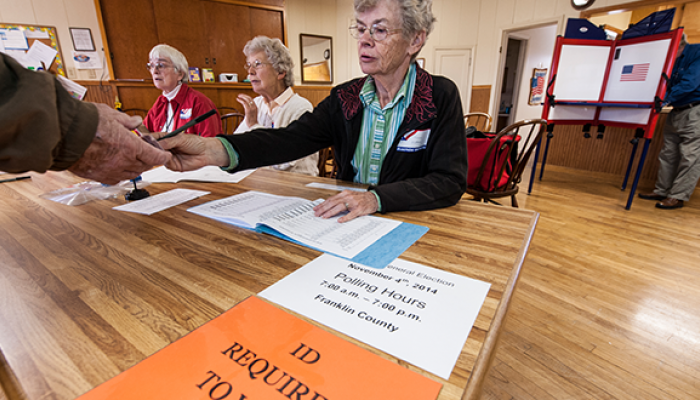Large-scale voter purges from Florida to Maine. Ultra-strict registration rules keeping voters off the rolls in Georgia and other states. Cuts to early voting sites in North Carolina. A North Dakota voter ID law that could keep Native Americans from the polls. False voting information being spread online.
Since the modern-day push to create barriers to voting got underway around a decade ago, the Brennan Center has been tracking restrictive voting laws and practices as closely as any organization in the country – as well as speaking out against them and challenging many in court. As Election Day 2018 approaches, citizens in 24 states are facing new laws making it harder for them to vote than it was in 2010. And in nine of those states, it’s harder to vote than it was in 2016. (We rounded up the range of voting problems we’ve seen in 2018 here). By our assessment, the range of voter suppression efforts has been more widespread, intense, and brazen this cycle than in any other since the modern-day assault on voting began, especially when viewed in combination with the accumulated new hurdles to voting.
A number of factors have converged to turn up the volume on voter suppression. First, by consistently and falsely stoking fear about illegal voting for over two years – including the lie that he’d have won the popular vote if it weren’t for millions of non-citizen voters – President Trump has helped make the issue central to the far right’s agenda. Trump’s short-lived voter fraud commission collapsed in January after drawing bipartisan outrage, but it nonetheless acted as a signal to supportive states that efforts to make voting harder would be welcomed at the highest levels. It’s no coincidence that in the first few months of Trump’s presidency, a slew of states proposed or passed new restrictions, after several years during which the pace had seemed to slow.
The courts also have played a key role. The Supreme Court’s 2013 ruling in Shelby County v. Holder, which neutered the most effective plank of the Voting Rights Act, offered a green light to a host of election rules changes in parts of the country whose voting rules previously had been under federal supervision. The court’s new staunchly conservative majority may be encouraging even states not directly affected by Shelby to lean forward on voter suppression, confident — we hope falsely — that the justices won’t stop them. The court recently declined to block North Dakota’s voter ID law, despite evidence that thousands of Native Americans who live on reservations could be stymied by its requirement that their IDs include a residential mailing address.
Of course, courts have also been major players in stemming the growth of voting restrictions. The number of court decisions against new restrictions has ballooned in recent years, with several finding that officials had intentionally tried to keep minorities from voting. But despite these victories, another troubling reality has emerged: Even when courts rule against restrictive voting measures, it isn’t enough to deter those looking to limit access to the ballot.
Litigation is typically time-consuming, and so these harsh laws often stay in place, fully intact and disenfranchising voters, for one or more election before a court rules against them. And even if that ruling does come, it may only weaken the law rather than striking it down fully — as happened with Texas’s and Wisconsin’s strict voter ID laws, among other examples. That half-a-loaf outcome gives would-be vote suppressors little incentive to think twice about their strategy. And in the cases when a court scraps a law entirely, the confusion and misinformation surrounding the process can often still keep some voters from the polls.
Equally troubling, those who seek to restrict access to voting do not seem to pay much of a political price. For example, the authors of North Carolina’s sweeping voter suppression law, struck down by a federal court which found it “targeted African-Americans with almost surgical precision,” did not lose their political perches — indeed, one of its key legislative champions now sits in the U.S. Senate, and the lawyer who defended the law has been nominated to be a federal judge. Put bluntly: In the absence of a broad Supreme Court ruling enforcing voting rights — something that is now an uphill battle at best — or strong federal legislation expanding the legal tools available to voters, the courts simply aren’t enough to combat voter suppression.
Finally, there’s race. There’s evidence that states in which the political clout of minorities is growing — where the ruling majority perceives a threat to its power — are more likely to see restrictive voting laws than are more demographically homogenous states. And as the salience of race in our politics has increased, so too has voter suppression.
A decade ago, there was a national spike in vote suppression efforts in the 2008 election cycle, when Barack Obama, backed by a multi-racial coalition, was bidding to become the nation’s first African-American president. That spurred unfounded fears that ACORN, a community group serving mostly minority communities, and its allied voter registration group for which Obama once worked, was plotting to steal the election on his behalf. Two years later, this resulted in the first massive wave of news laws cutting back on voting access. In the age of Trump, politicians have grown more comfortable openly playing to these fears. And this year, two of the highest-profile statewide races feature progressive African-American candidates – one the founder of a voter registration group – running against white conservative Trump supporters.
Partisanship plays a role too. Voting restrictions have almost exclusively been promoted and supported by Republicans. As our country becomes more polarized, the partisan divide on voting rights has taken on greater import.
Causes aside, here’s the grim reality: The scope and sophistication of efforts to make voting more difficult make clear that voting advocates can’t respond solely by playing a defensive whack-a-mole against the worst laws and practices. That crucial work will continue, but it must be paired with a positive reform agenda — one that is gaining momentum at the state level — that bolsters protections for the right to vote and expands access to the ballot. Adding to this momentum, on Tuesday voters in four states will consider ballot initiatives to expand access to voting (in addition to four ballot initiatives to improve the redistricting process). After Election Day, it will be up to the new Congress and state legislatures to take up voting rights.
We faced even worse voter suppression schemes before the 1965 Voting Rights Act, and we responded by making our democracy stronger. We should do so again.
(Image: Julie Denesha/Getty)




